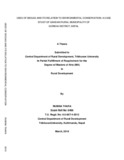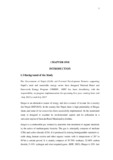Please use this identifier to cite or link to this item:
https://elibrary.tucl.edu.np/handle/123456789/2365| Title: | Uses of Biogas and its Relation to Environmental Conservation: A Case Study of Gandaki Rural Municipality of Gorkha District, Nepal |
| Authors: | Thapa, Rubina |
| Keywords: | Biogas;Farming System;Rural development |
| Issue Date: | 2019 |
| Publisher: | Central Department of Rural Development |
| Abstract: | Biogas technology adoption has been advanced around the world as a renewable source of energy by various organizations such as government agencies and Non- government Organizations. The advancement of the technology is due to its health and environmental benefits. In its effort to achieve its vision, the government aspires to encourage wider adoption and use of biogas technology as one of the renewable energy sources. The focus of this study is on status of biogas and its relation to environmental conservation. In the study area, the objectives of the study were: to find out the various uses and economic benefit of biogas as well as its role in the improvement of health, sanitation and environmental protection. The present study was carried out in Gandaki Rural Municipality of Gorkha District, which is located in the Province No. 4 of Gandaki. The economic status was average and agriculture was the main occupation. Since nobody did any kind of research in this area. Descriptive survey research design was used. The sample size comprised of 60 respondents who were purposively sampled to fulfill the objectives of the study. The study has been based on both secondary and primary data and information. The total 60 respondents are from local community of Gandaki Rural Municipality, irrespective of gender, caste and age. Among them 55 percent are female and remaining males. The findings from the study revealed that the significant adoption of the biogas technology were its various uses, economic benefits, and improvements in the health, sanitation and environmental protection. Most of the households were satisfied through the installation while some of them argued about its negative impacts like increment of the mosquitoes, flies and other unwanted insects. Almost 73.33 percent of the respondents were engaged in agriculture and remaining were in other types of occupation such as business, social work, teacher, service, etc. The average number of livestock (cattle and buffalo) per household was 9.36 percentof cow/ox, 16.96 percent of buffalo and 73.67 percent of goats. Goats were more admired by the households as more creation of gas and less costly as well as owns them more. About 70 percent households have biogas and remaining 20 percent use firewood and kerosene and other 10 percent have L.P.G subsidies too. 90 percent use biogas plant in daily basis and remaining 10 percent use it manually as biogas plant was collapsed due to earthquake 2072. The size of biogas plant is mostly determined by the number of family members and the number of cattle. 90 percent of the respondents have constructed biogas plant of 6 ghana meter and the remaining 10 percent have constructed the biogas of 8 ghana meter. In the matter of connecting toilet, 81.66 percent households have connected toilet with biogas plant and remaining 18.33 percent have no connection of toilet with the plant due to cultural belief and enough number of cattle. Finally the study recommends that for the long lasting period of the biogas technology adoption in the sampled area, the government should re-shape its plans and policies and process as per mentioned in the recommendation. |
| URI: | http://elibrary.tucl.edu.np/handle/123456789/2365 |
| Appears in Collections: | Rural Development |
Files in This Item:
| File | Description | Size | Format | |
|---|---|---|---|---|
| Cover Page-4.pdf | 867.19 kB | Adobe PDF |  View/Open | |
| CHAPTER ONE-3.pdf | 1.14 MB | Adobe PDF |  View/Open |
Items in DSpace are protected by copyright, with all rights reserved, unless otherwise indicated.
